2025 Influencer marketing report: Trends and statistics for influencer marketing, UGC, and the creator economy
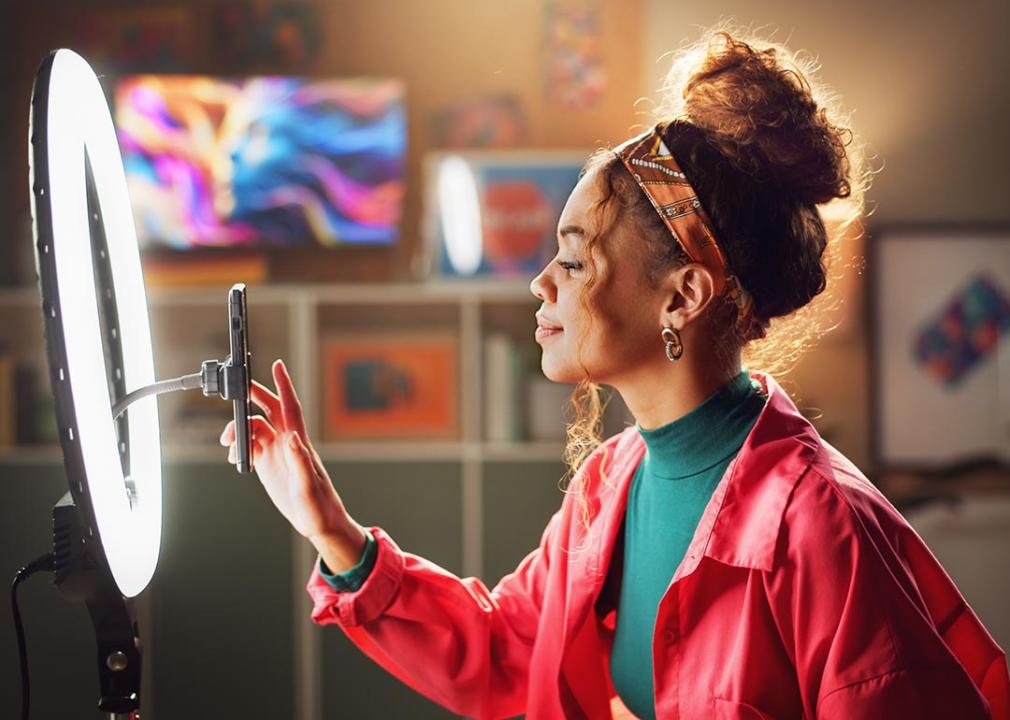
Yuri A // Shutterstock
2025 Influencer marketing report: Trends and statistics for influencer marketing, UGC, and the creator economy
Since 2022, Collabstr's annual report, which spotlights the trends and insights shaping the influencer marketing scene, has become a go-to resource for brands and creators alike.
Backed by first-party data sourced directly from Collabstr's extensive influencer marketplace, this year's report dives into data from 40,000 advertisers and 100,000 creators.
Here's a closer look at how the influencer economy has grown over the past year and a few data-backed predictions.
Key Highlights
- The influencer marketing industry is set to grow 12.12% to $22.2 billion in 2025.
- The global creator economy is projected to grow from $191 billion in 2025 to $528.39 billion by 2030, with an impressive 22.5% CAGR.
- The number of user-generated content (UGC) creators has surged by 93% year over year, reflecting the growing power of everyday influencers.
- Brands in 2025 spend around $202 per influencer collaboration, down from the previous year, attributed to an influx of new creators in the market.
- Females continue to dominate influencer marketing, holding a 70% share of the market, underscoring their leading role in the space.
- Males creators are paid $83 (40%) more on average than female creators.
- AI-supported content and AI influencers are becoming a trending topic.
![]()
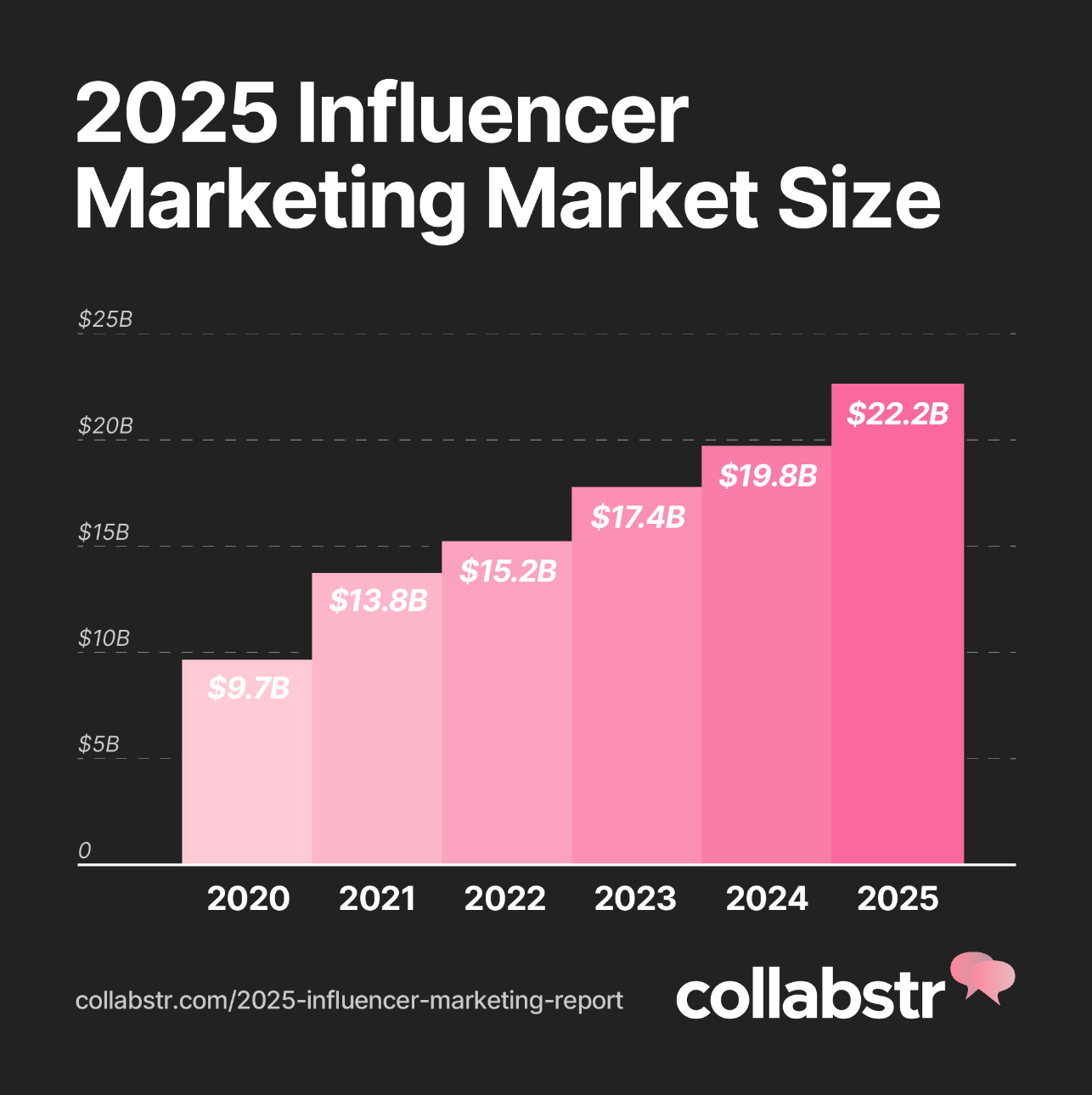
Collabstr
Influencer Marketing Market Size in 2025
Statista projects the influencer marketing market will reach $22.2 billion by 2025. That's approximately 12.12% from 2024 to 2025. That's slightly less growth from 2023 to 2024, which was approximately 13.9%.
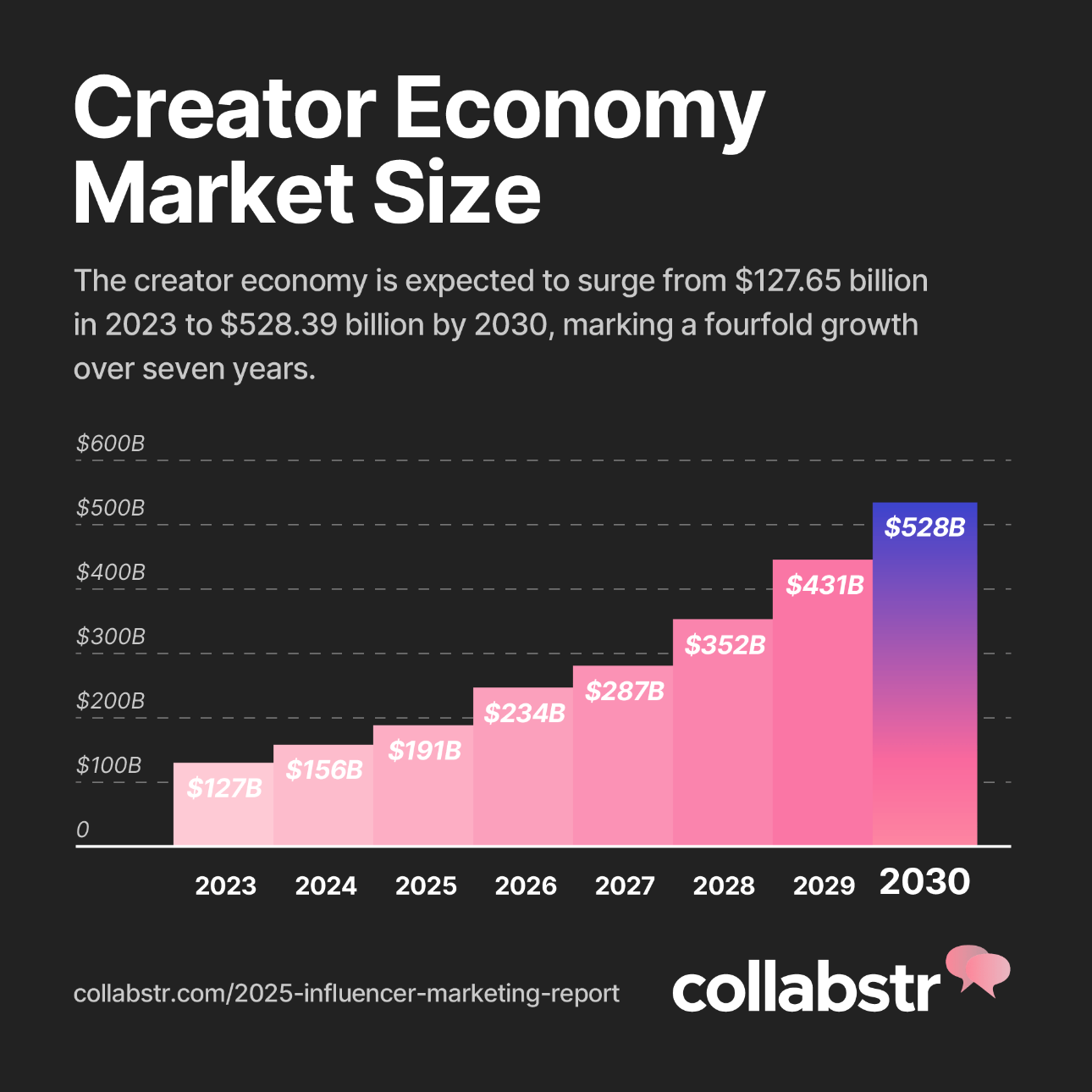
Collabstr
Size of the Creator Economy in 2025
From 2024 to 2025, the creator economy is expected to grow by 22.50%.
"This year's list shows that the creator economy is growing fast—and growing up," says Steven Bertoni, Assistant Managing Editor, Forbes. According to Bertoni, "Creators are harnessing their social influence to evolve from entertainers to entrepreneurs and building their own brands. Others continue to jump from phone screens to mainstream media. And in an industry once built on selfies, many are building streaming studios. The ecosystem will only get bigger and more powerful."
One example of this evolution is TikTok star and content creator Addison Rae, who has built her mainstream media popularity with her debut on the big screen in 2021, a music career, and an upcoming film with Ryan Reynolds in 2025.
Non-celebrity creators have also jumped on the bandwagon, diversifying their income streams with consumer goods companies. The brand Sour Strips, which has generated $20 million in revenue in 2024, was created by Maxx Chewning, who started his content career as a fitness YouTuber amassing over 300,000 subscribers. Owing to his love for sour candy, the idea for Sour Strips was born. The brand's success was so big that it was recently acquired by Hershey's for an undisclosed amount.
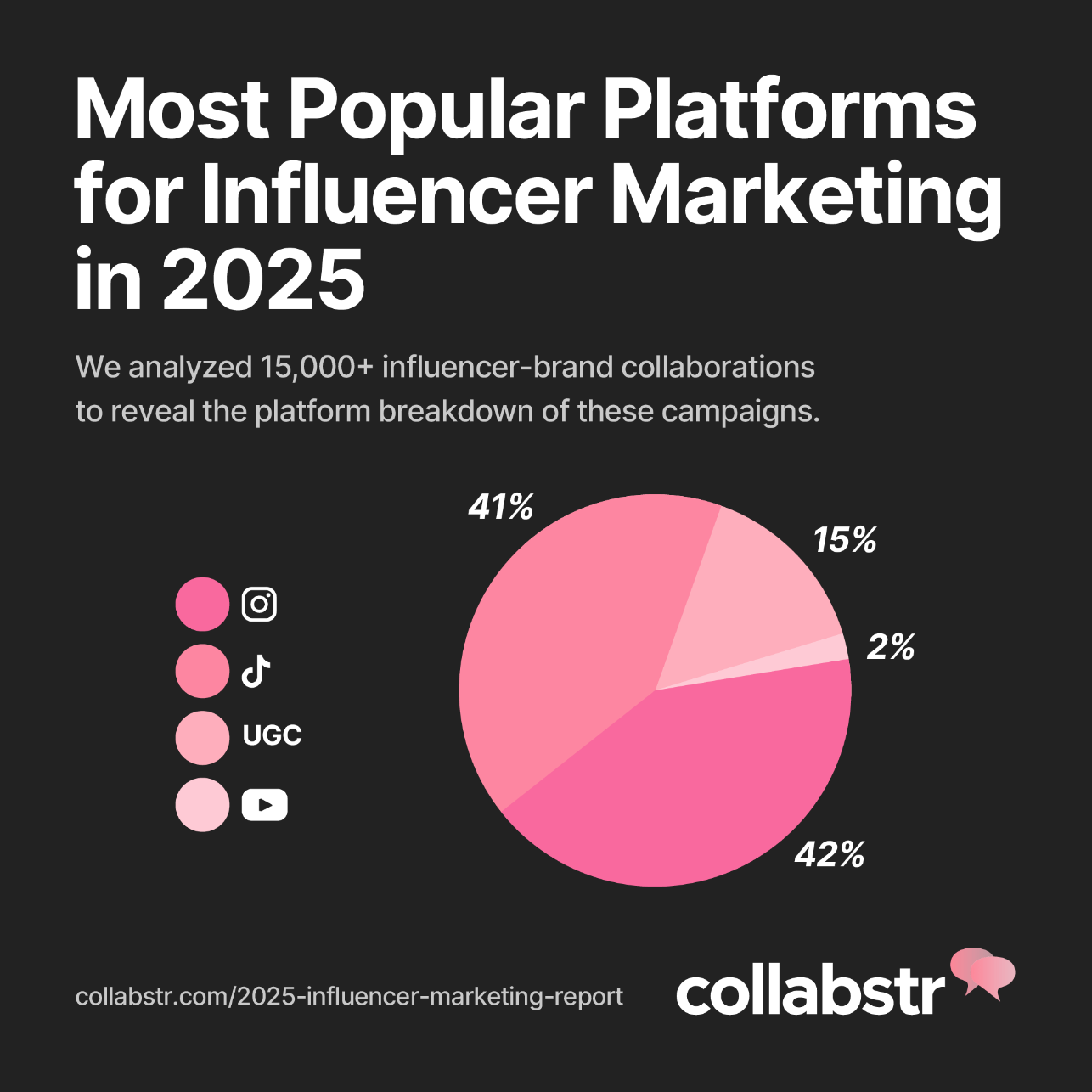
Collabstr
Most Popular Platforms for Influencer Marketing in 2025
Collabstr examined 10,000 collaborations between influencers and brands to find out the percentage of campaigns on TikTok, Instagram, YouTube, and user-generated content, or UGC. 42% of influencer campaigns occurred on Instagram in 2024. TikTok is next, with 41% of influencer campaigns occurring on the platform.
Despite TikTok being a relatively new platform, it's already grown a userbase almost equivalent to Instagram. TikTok is expected to reach 1.8 billion monthly active users by the end of 2024, while Instagram already has 2 billion monthly active users by the same time.
While many brands still perceive TikTok as a platform dominated by younger, less affluent audiences, the data tells a different story. In 2024, more millennials are actively using TikTok, with 30% of U.S. TikTok users falling into the 25-34 age range. In fact, 55% of TikTok users are under 30, demonstrating that the platform attracts a more mature and diverse audience than its early reputation suggests. This shift indicates that TikTok is no longer just a Gen Z territory. It's becoming a key platform for engaging millennial audiences with disposable income, making it a viable advertising channel for brands targeting this demographic.
UGC market share also grew this year, with 15% of influencer collaborations being UGC campaigns. This shows growing need for non-branded content.
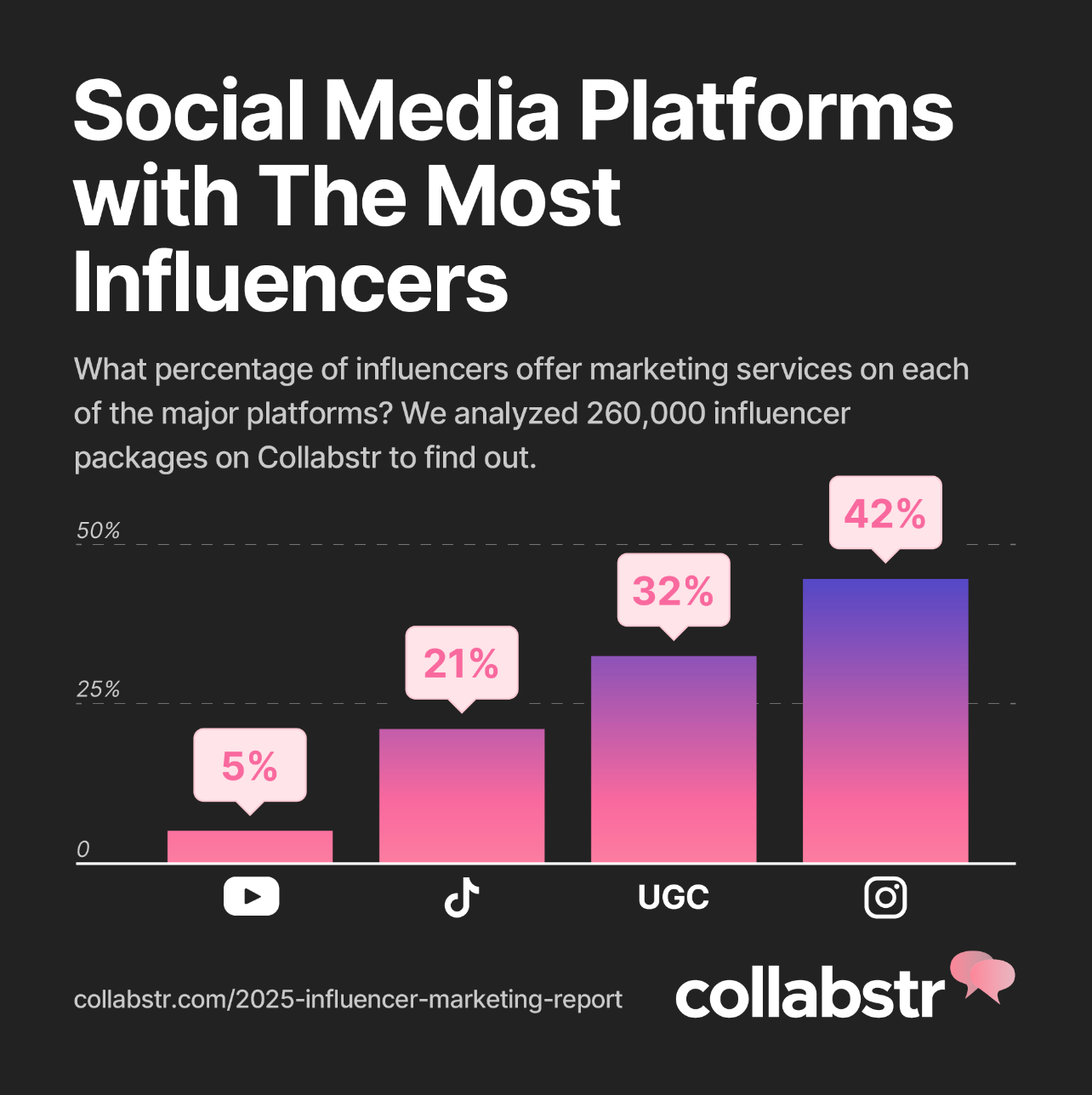
Collabstr
Which Platforms Have the Most Influencers?
Collabstr analyzed 262,000 influencer packages to determine where influencers are most open to influencer marketing with brands:
According to recent data, 79% of marketers feel that Instagram is the best platform for reaping the benefits of influencer marketing. Its massive user base and features designed for branded collaborations make it a go-to for reaching a wide audience. At the same time, user-generated content is stealing the spotlight across platforms—according to BIllo, 93% of marketers who use UGC say it outperforms traditional branded content. Consumers agree, with six in 10 believing UGC feels more authentic than any other form of marketing.
TikTok is often perceived as a platform primarily for Gen Z users. However, with over 1.8 billion monthly active users as of 2024, its user base is expanding across various age groups. As the platform continues to evolve, this perception is expected to shift, leading to broader adoption among brands and creators.
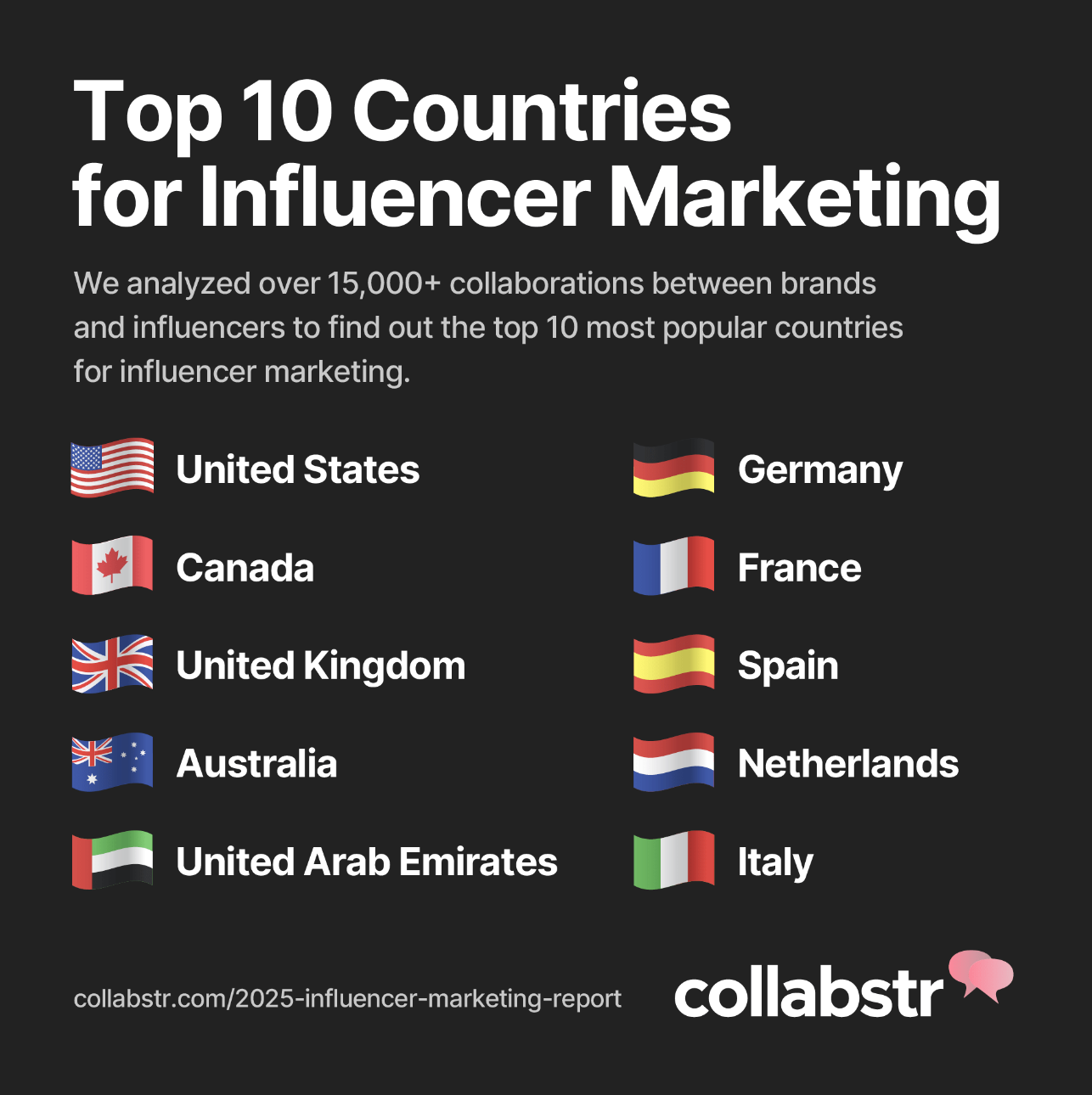
Collabstr
Top 10 Countries for Influencer Marketing
Collabstr analyzed over 15,000 collaborations between brands and influencers to find out the top 10 most popular countries for influencer marketing:
Countries that remained in the same positions:
- United States (#1)
- Canada (#2)
- United Kingdom (#3)
- Australia (#4)
The above countries retained their rankings as the most popular for influencer marketing. The United States, Canada, the U.K., and Australia have strong economies that support high levels of consumer spending and robust marketing budgets. Plus, these countries have high internet and social media usage rates, and a large and engaged audience for influencer campaigns. Platforms like Instagram, TikTok, and YouTube are immensely popular in these regions.
Active social media usage data from Backlinko supports the above ranking:
- USA has 72.5% active users regardless of age, 77.4% for only those aged 18+ years
- U.K. has 82.0% regardless of age, 90.4% for only those aged 18+ years
- Canada has 77.2% regardless of age, 87.5% for only those aged 18+ years
- Australia has 77.2% regardless of age, 86.0% for only those aged 18+ years
Countries that left the top 10:
- Mexico
- Romania
Mexico and Romania, both part of the 2023 top 10, have fallen off the 2024 list, which may reflect a shift in how influencer marketing is executed in these regions. As Mirela Enache, Media Research Specialist at Starcom Romania, explains, "In the past, simply including an influencer in a marketing campaign was often enough to attract attention. Now, a detailed strategy is essential, selecting influencers who align with the brand and crafting a creative concept tailored to specific goals." This suggests that the drop could be linked to brands in these regions struggling to adapt to the increasing demand for more strategic campaigns, which are now critical for success in a competitive global market.
New countries that entered the top 10 in 2024:
- United Arab Emirates (#5)
- Netherlands (#9)
The UAE's influencer landscape is experiencing a growth spurt in ad spending, which is expected to grow at an annual rate of 10.04% from 2023 to 2027. In addition, ad spending in the Influencer Advertising market in the Netherlands is forecasted to reach US$185.10 million in 2024.
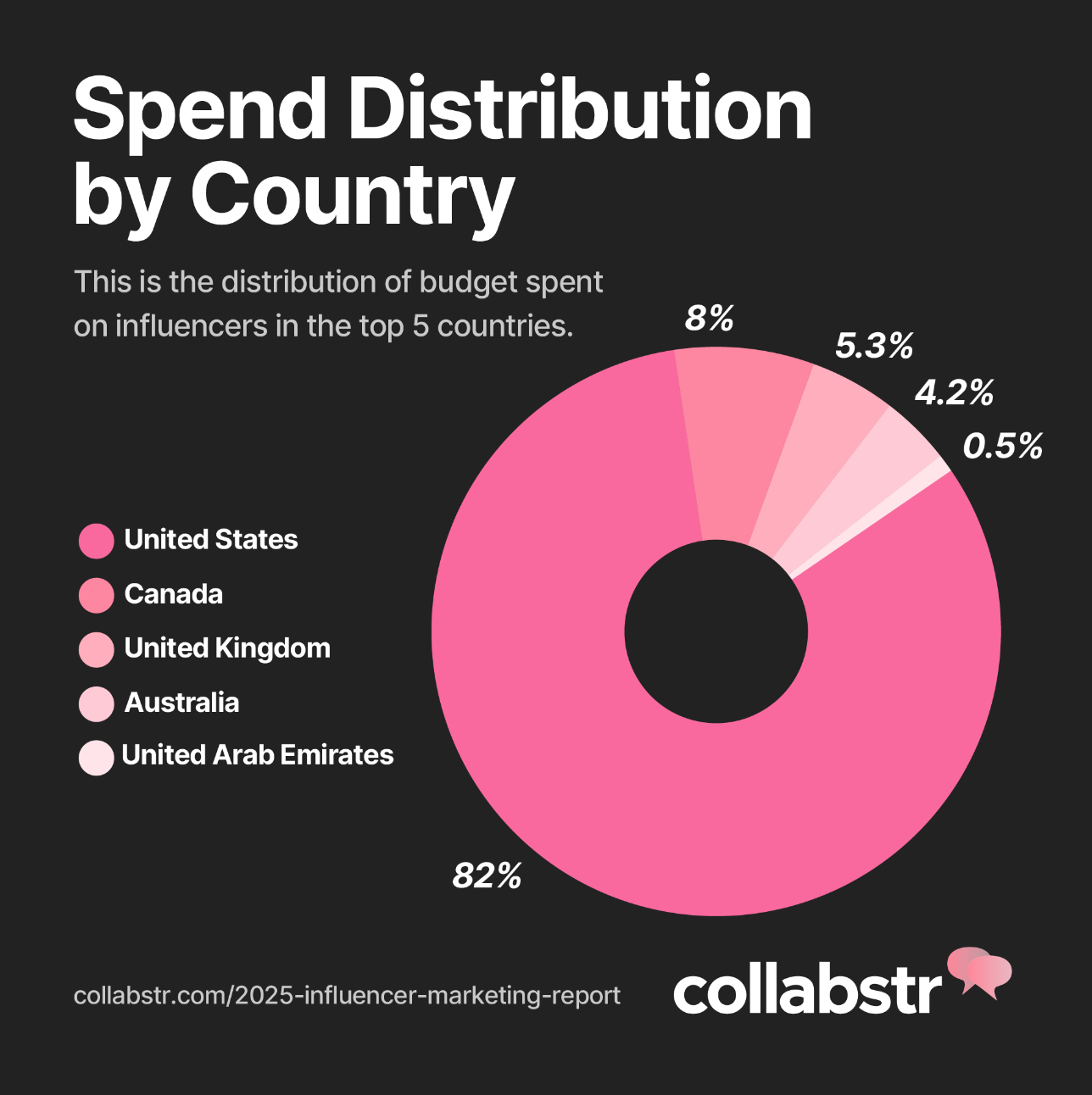
Collabstr
Influencer Spend Distribution by Country
Last year, 77% of global influencer ad spend targeted the U.S. market, rising to 82% in 2024. This growth explains the U.S.'s dominance as a top market for influencer campaigns, attracting both local and international budgets. For example, a German company might allocate more of its budget to the U.S. for a higher return on investment.
Meanwhile, the U.K.'s share dropped from 8% to 5.3%, Australia's from 5% to 4.2%, and Canada's from 10% to 8%. These shifts reflect a global redistribution of budgets, with brands prioritizing regions offering better value and higher returns.
Top Cities for Influencers in Each Country
USA
The top five cities for influencers in the U.S. are Los Angeles, New York, Miami, Atlanta, and Dallas.
The top cities remained the same. However, Tampa left the top five and Dallas earned the 5th position. That could be due to local partnerships taking center stage. In cities like Dallas, businesses are teaming up with local influencers to connect with their communities in a more genuine and impactful way. This strategy strikes a chord with audiences who prioritize authenticity and appreciate brands that understand and celebrate their local roots.
Canada
The top five cities for influencers in Canada are Toronto, Vancouver, Montreal, Calgary, and Ottawa.
Ottawa dropped in rankings, Edmonton fell off the list, and Calgary rose to claim 4th position.
United Kingdom
The top five cities for influencers in the U.K. are London, Manchester, Leeds, Kent and Glasgow.
Birmingham dropped out of the rankings, Bristol followed suit, while Kent and Glasgow made their debut on the list.
A few recent trends that could explain this. In Glasgow's thriving cafe scene, influencer marketing has become a key strategy for building brand awareness and driving customer engagement. By partnering with influencers, local businesses are connecting with their audience in fresh and impactful ways.
Australia
The top five cities for influencers in Australia are Sydney, Melbourne, Perth, Gold Coast, and Brisbane.
United Arab Emirates
The top cities for influencers in the UAE are Dubai, Abu Dhabi, and Ajman.
Dubai and Abu Dhabi are the largest cities in the UAE, so it's no surprise that the influencer scene is largest there. Ajman is also within the seven major cities in the UAE.
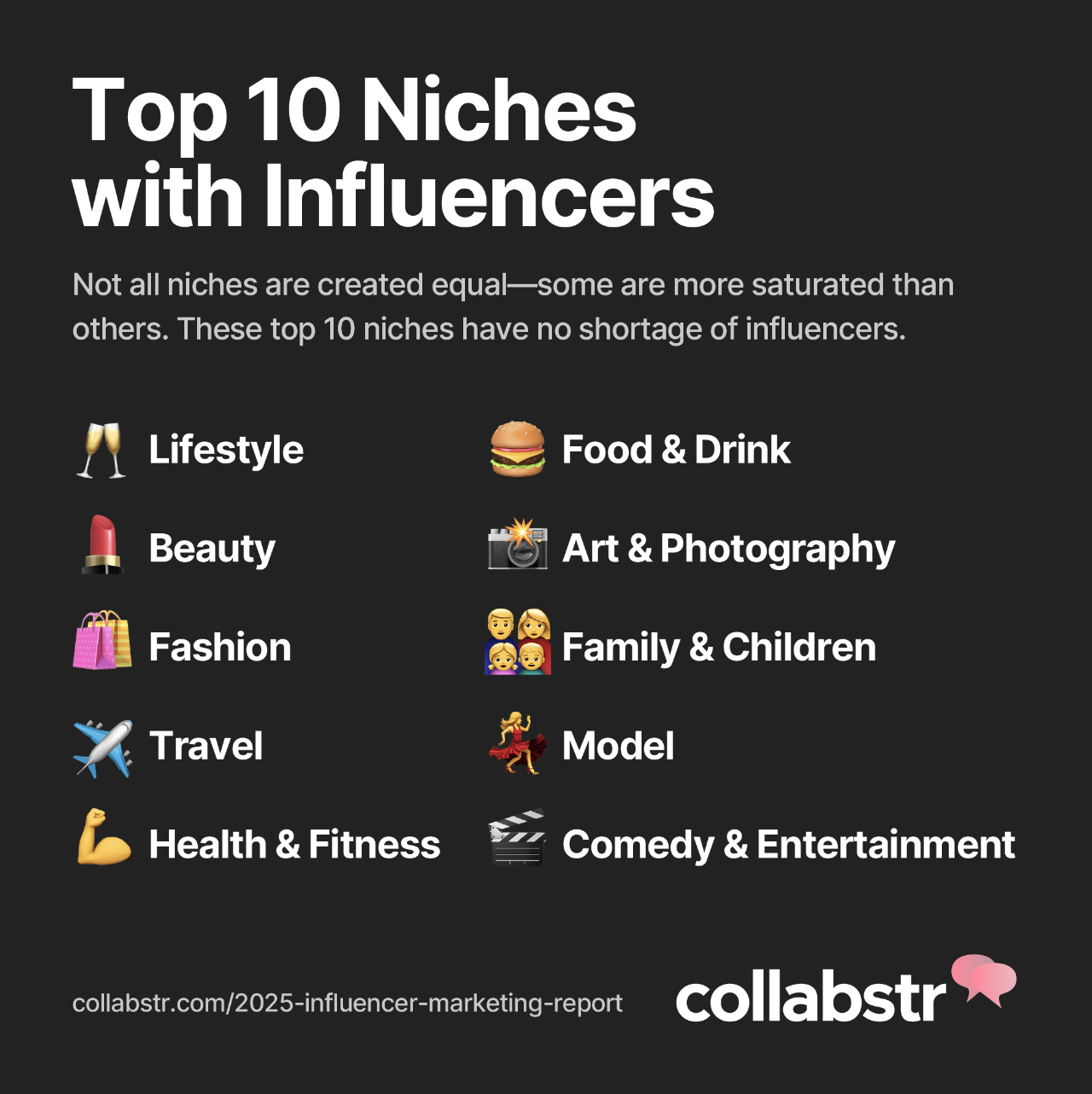
Collabstr
Top 10 Industries With Influencers
These are the industries with the most influencers in them. The top industries remain nearly the same as in previous years, the only difference being Family & Children entering the scene. This category is largely driven by the "mommy vloggers" epidemic, as well as the growing and powerful mom influencer segment in general. Currently, over 4.2 million individuals identify as mom influencers, thanks to their ability to share practical parenting tips with family-oriented audiences.
Top 10 In-Demand Influencer Niches
These are the niches/industries where influencers are in the highest demand, based on 1 million+ searches analyzed on Collabstr.
- Fashion
- Beauty
- Lifestyle
- Health & Fitness
- Food & Drink
- Travel
- Family & Children
- Entrepreneur Business
- Music Dance
- Technology
The entrepreneurship and technology niches are also seeing spikes in growth. The rise of AI has sparked a new generation of content creators focused on promoting AI-driven tools like PhotoRoom, which helps other creators produce professional-grade visuals from their phones.
Influencer Pricing in 2025
Average Price Per Influencer in 2025
Collabstr analyzed 15,000+ influencer collaborations in 2025, and the average spend per influencer was $202. This is a drop from last year, when brands usually spent $214 on an influencer collaboration. This decrease makes sense when considering the growing supply of influencers in the market, which continues to expand rapidly. Approximately 2.4% of global social media users—totaling around 127 million individuals—are now considered influencers, reflecting the significant and ongoing growth of the creator economy.
As more creators enter the space, competition among influencers drives prices to normalize, making collaborations more accessible for brands with varying budgets.
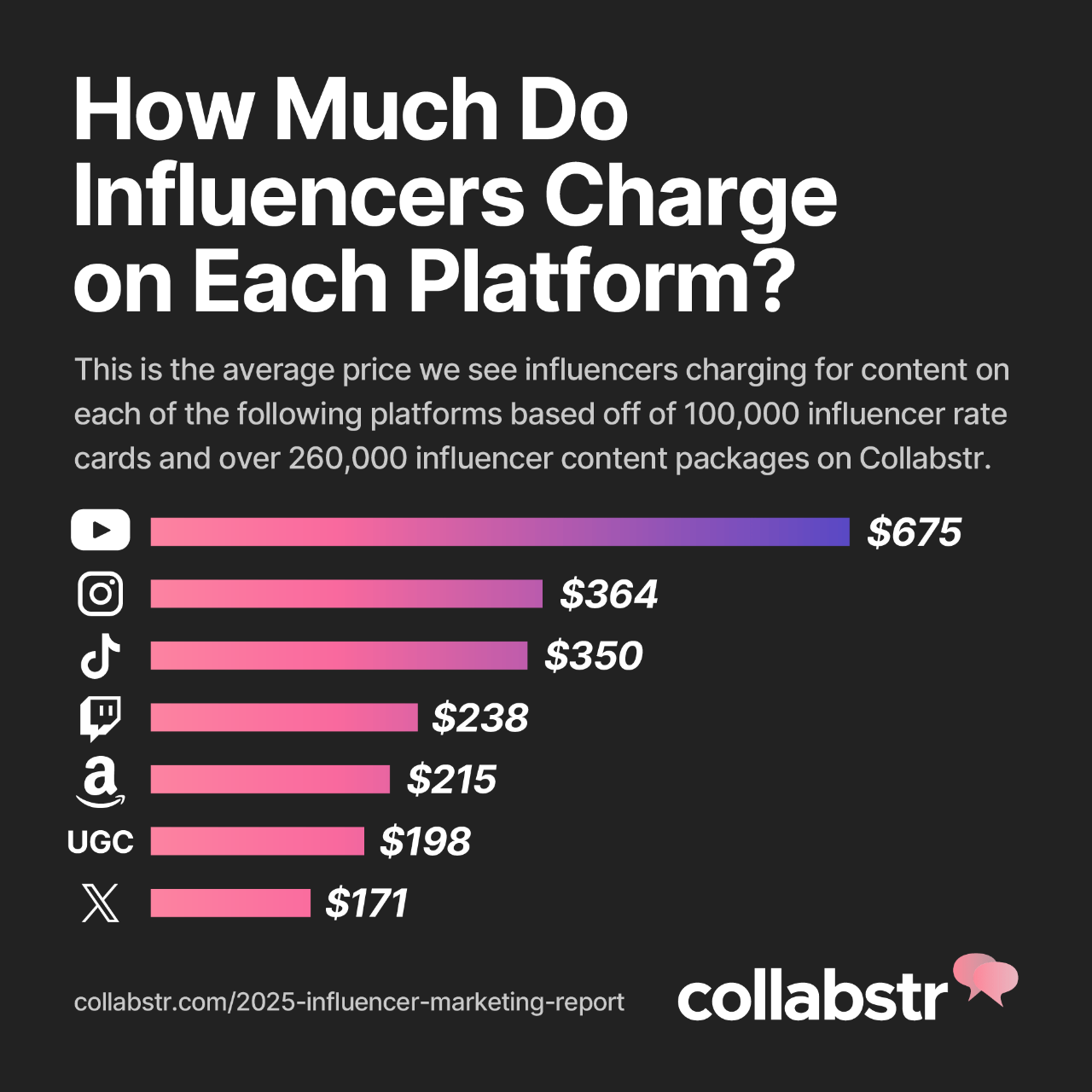
Collabstr
How Much Do Influencers Charge on Each Platform?
This is the average asking price for influencer content on the following platforms. This is not indicative of what brands actually pay influencers, but rather what influencers ask brands to pay them. Last year, Collabstr only had data on Instagram, TikTok, UGC, and YouTube. This year, there are a few extra platforms.
- YouTube: $675.23
- Instagram: $363.64
- TikTok: $350.06
- Twitch: $237.72
- Amazon: $215.10
- User Generated Content: $198.06
- Twitter: $171.35
When compared to last year's report, there's been an overall drop in prices:
- Instagram: Prices decreased by approximately 13.00%.
- TikTok: Prices decreased by approximately 32.68%.
- User-Generated Content (UGC): Prices decreased by approximately 44.37%.
- YouTube: Prices decreased by approximately 17.25%.
Each platform experienced a significant drop in average pricing, with UGC showing the steepest decline. This could be due to the higher return and engagement from micro-influencers who charge less and the increasing supply of creators across the board. As the market becomes saturated, the classic principles of supply and demand drive prices down, giving brands more negotiating power and access to cost-effective collaborations.
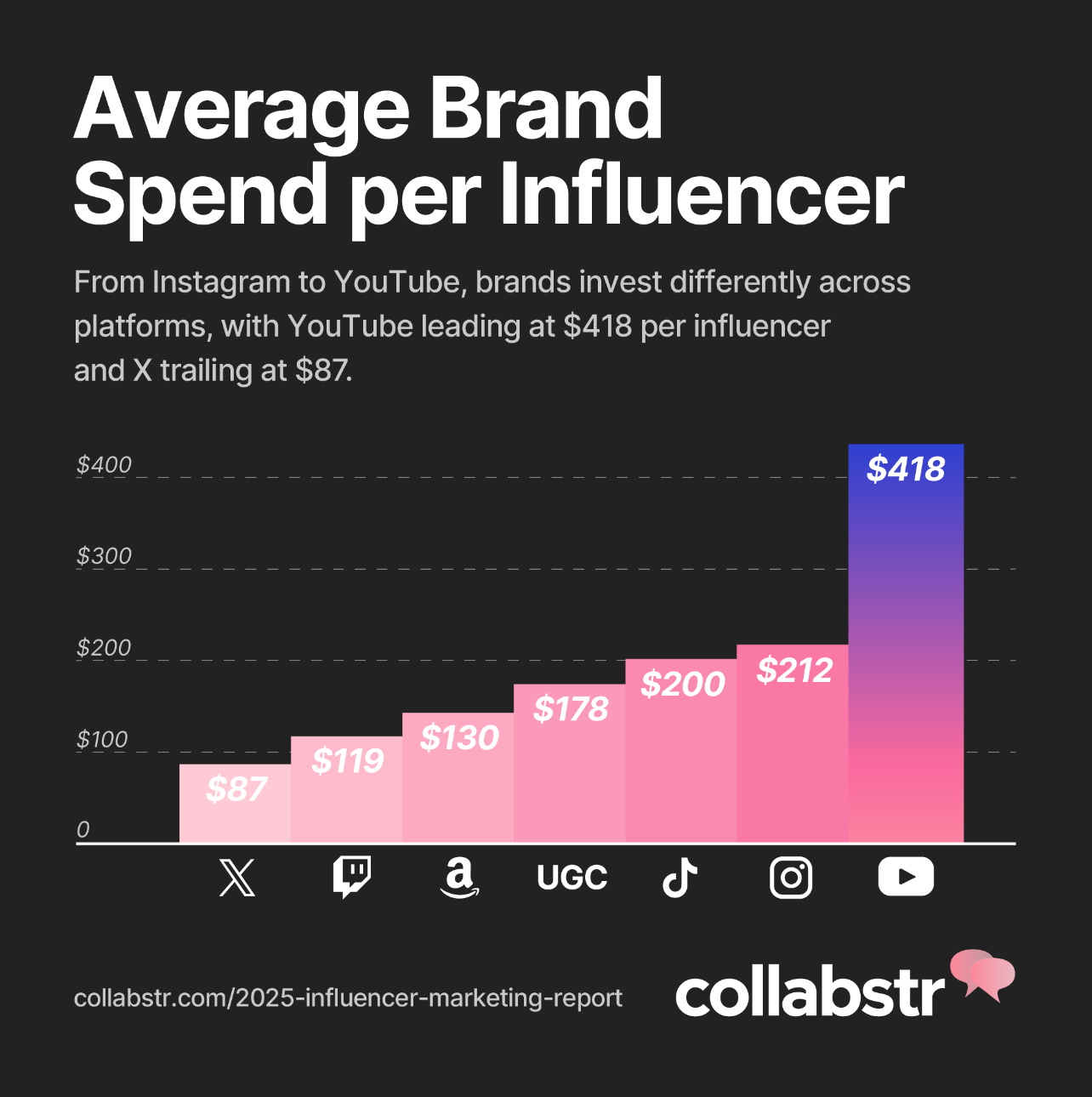
Collabstr
How Much Do Brands Spend per Influencer on Each Platform?
This is a list of how much brands spend per influencer on average for each specific platform. Brands almost always pay less than the average asking price of influencers.
- Amazon: $130.41
- Instagram: $212.21
- YouTube: $418.09
- Twitter: $87.10
- TikTok: $200.22
- User Generated Content: $177.68
- Twitch: $118.93
Now, the question becomes: How does real spend differ from what the influencers are asking for? Here's a deeper analysis.
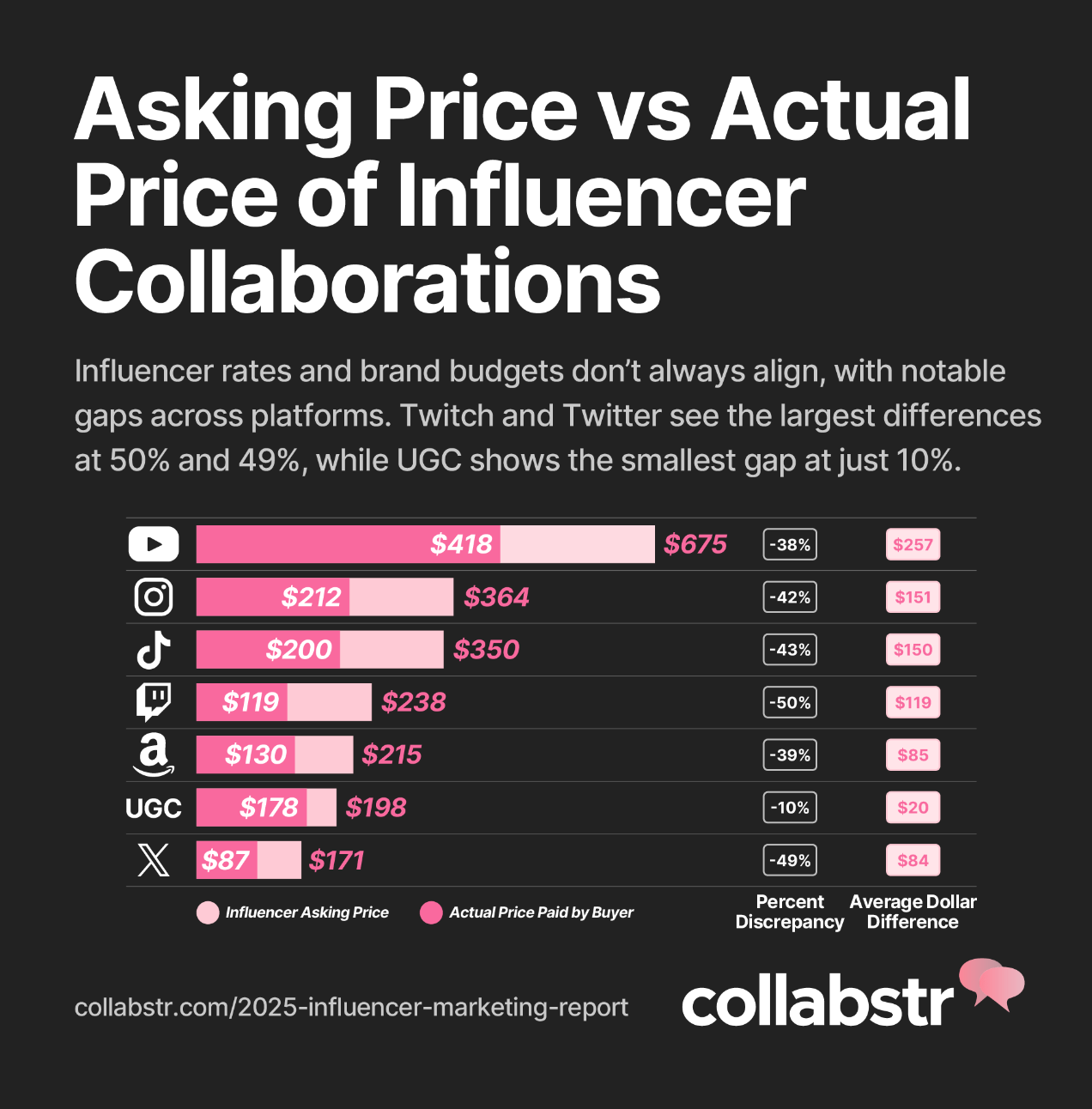
Collabstr
Asking Price vs. Actual Price of Influencer Collaborations
The data shows that while influencers set high asking prices, buyers have the upper hand in negotiating lower fees.
UGC has the smallest discrepancy at 10.29% (a dollar difference of just $20.38 on average). This smaller gap suggests UGC pricing is more standardized and aligned with buyer expectations. UGC often comes from creators who are not necessarily traditional influencers in terms of large followings and a polished presence. As a result, this may keep their pricing more competitive. Additionally, brands increasingly rely on UGC because it delivers authenticity and better ROI.
On the other hand, Twitch (49.97%) and X (Twitter) (49.17%) have the largest percentage gaps. This could indicate lower perceived value by buyers. Here are a couple of factors that could explain those differences:
- Twitch's audience is dominated by younger users who may prefer authentic, organic interactions over disruptive advertising. This preference can make traditional marketing approaches less effective, prompting brands to be cautious with their spending and negotiate lower fees. In addition, Twitch's long-form focus may not align with all brand strategies, especially those seeking quick, high-impact impressions. This misalignment can influence brands to allocate budgets elsewhere.
- As for Twitter (now X), its ad spending dropped $238 million as major brands pulled back in 2024. Platforms like Instagram, TikTok, and YouTube provide better tools for influencer content creation, tracking, and engagement. This competitive disadvantage, combined with its revenue decline, means Xs influencer marketing could be seen as less reliable.
Price Difference Between Instagram Reels and TikTok Videos
Upon analyzing 15,000 collaborations between influencers and brands, Instagram Reels are 32% more expensive than TikTok videos on average.
- Instagram Reel Average Price: $288
- TikTok Video Average Price: $217
Instagram's algorithm prioritizes reels, which can be easily repurposed into TikToks and vice-versa. Because Instagram actively pushes Reels over other types of posts, brands see them as a way to maximize reach and engagement. This increased perceived value allows influencers to charge more.
Adding to that, Instagram Reels consistently deliver higher engagement, outperforming single-image posts by 55% and standard videos by 29%. This makes Reels a valuable tool for brands looking to maximize reach and interactions, justifying why influencers can charge more for this format.
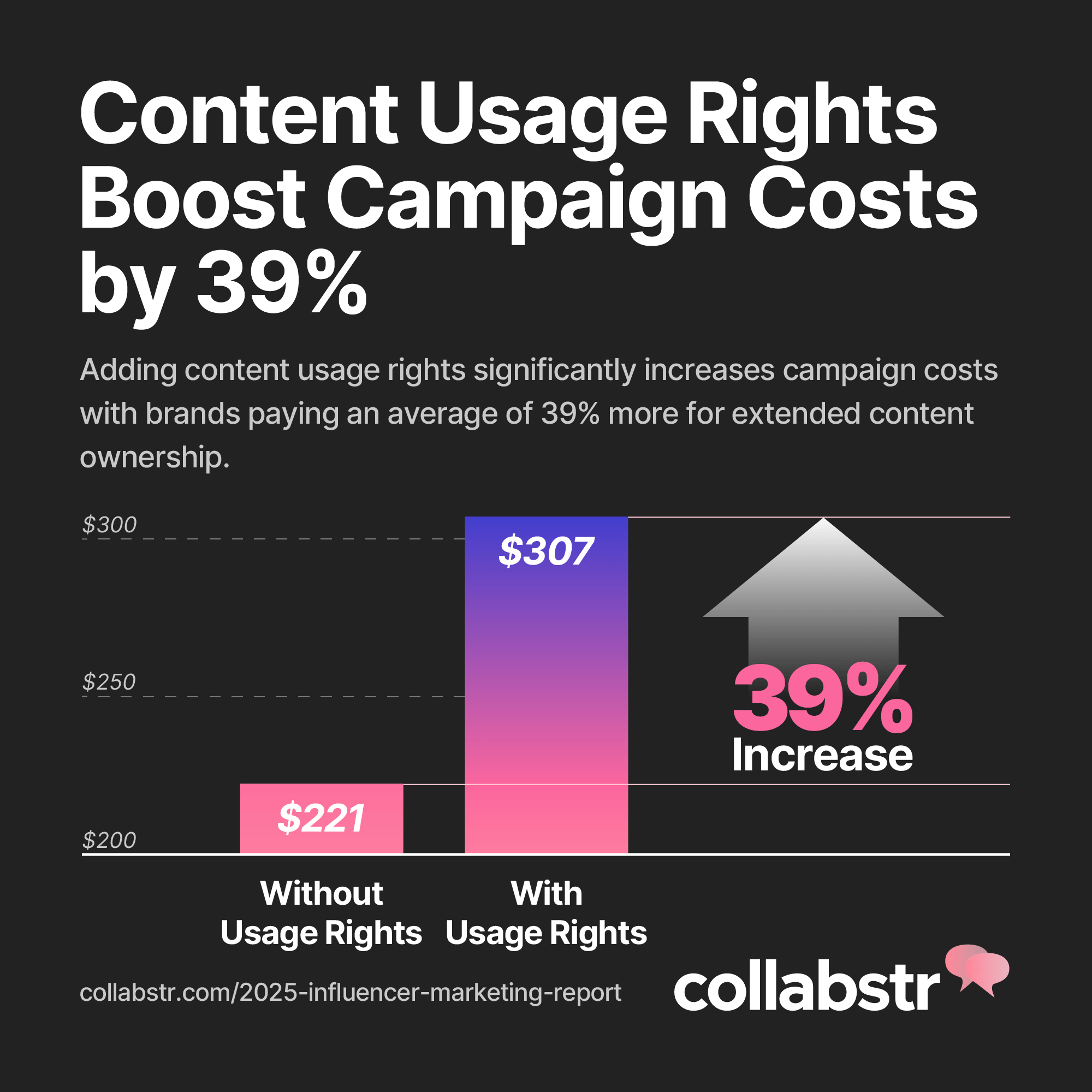
Collabstr
Content Usage Rights Boost Campaign Costs by 39.91%
The following data shows how content usage rights affect the pricing of influencer campaigns. When usage rights are added, the price tends to increase.
- Average price with no usage rights: $221
- Average price with usage rights: $307
- Price difference: 39%
Usage rights refer to the permissions a brand acquires to reuse influencer-created content beyond the initial campaign, such as in ads, websites, or other marketing materials. When added to the contract, this drives up costs because the content becomes a long-term asset for the brand.
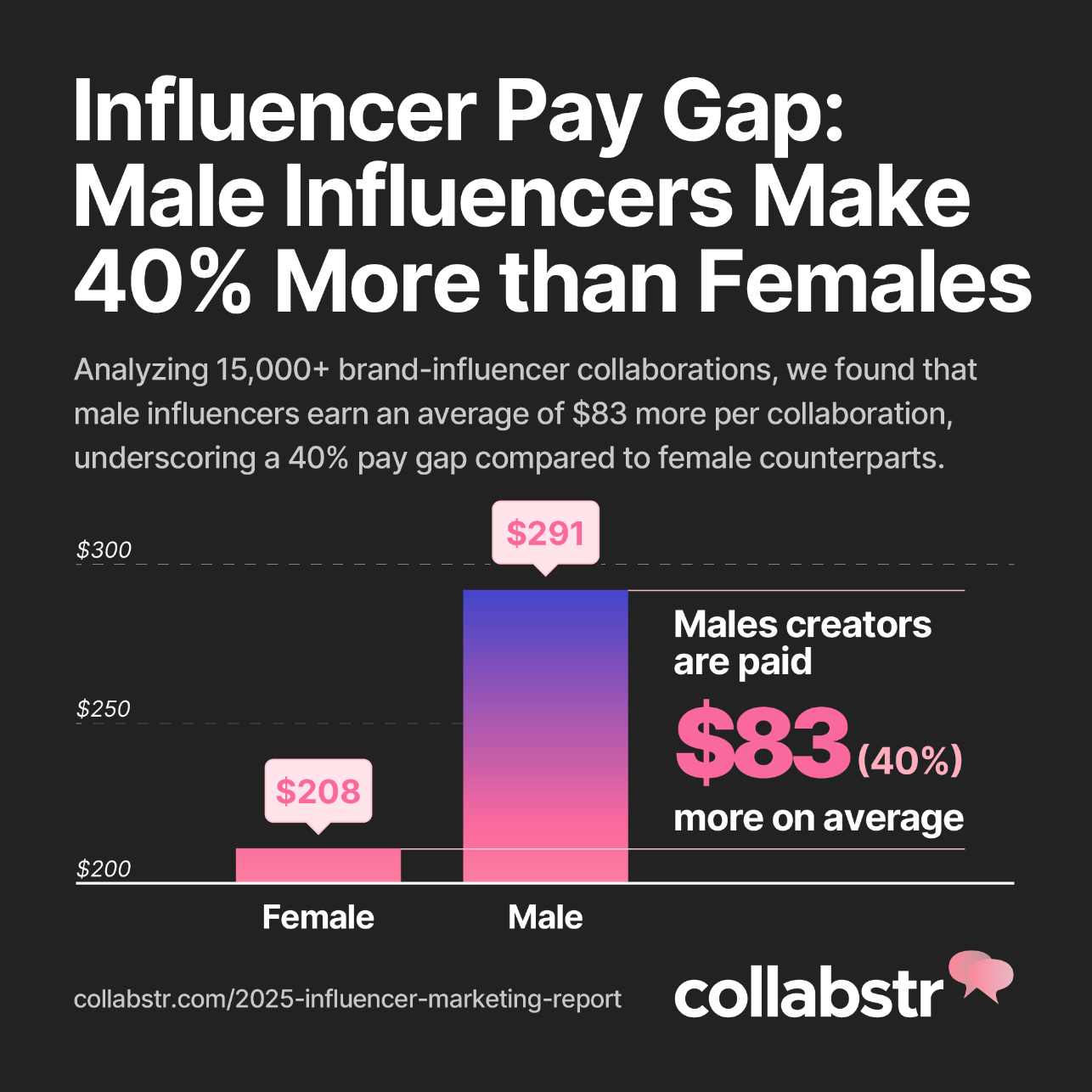
Collabstr
Male Influencers Earn 40% More Than Females
Collabstr analyzed 15,000+ influencer collaborations and found that male influencers tend to make 40% more than their female counterparts per collaboration. With this case being heavily focused on micro-influencers, it came out to an average difference in payment of $83 between males and females.
It's possible the abundance of female creators, especially at the micro-influencer level, result in prices female influencers being driven down compared to their male counterparts. With there being less males than female influencers, the males naturally can command a hiring asking price due to limited supply.
Also, the gender pay gap in influencer marketing can be partly attributed to perceptions tied to the titles "influencer" and "content creator," as highlighted by Sensis Agency. Women are more frequently referred to as "influencers," while men often identify as "content creators." This subtle distinction carries significant implications. The term "influencer" suggests a more passive role, focused on persuading audiences, whereas "content creator" implies active production and creativity. These differing perceptions may lead to women being undervalued, with their contributions seen as less substantial compared to their male counterparts who are viewed as "producers" of original content.
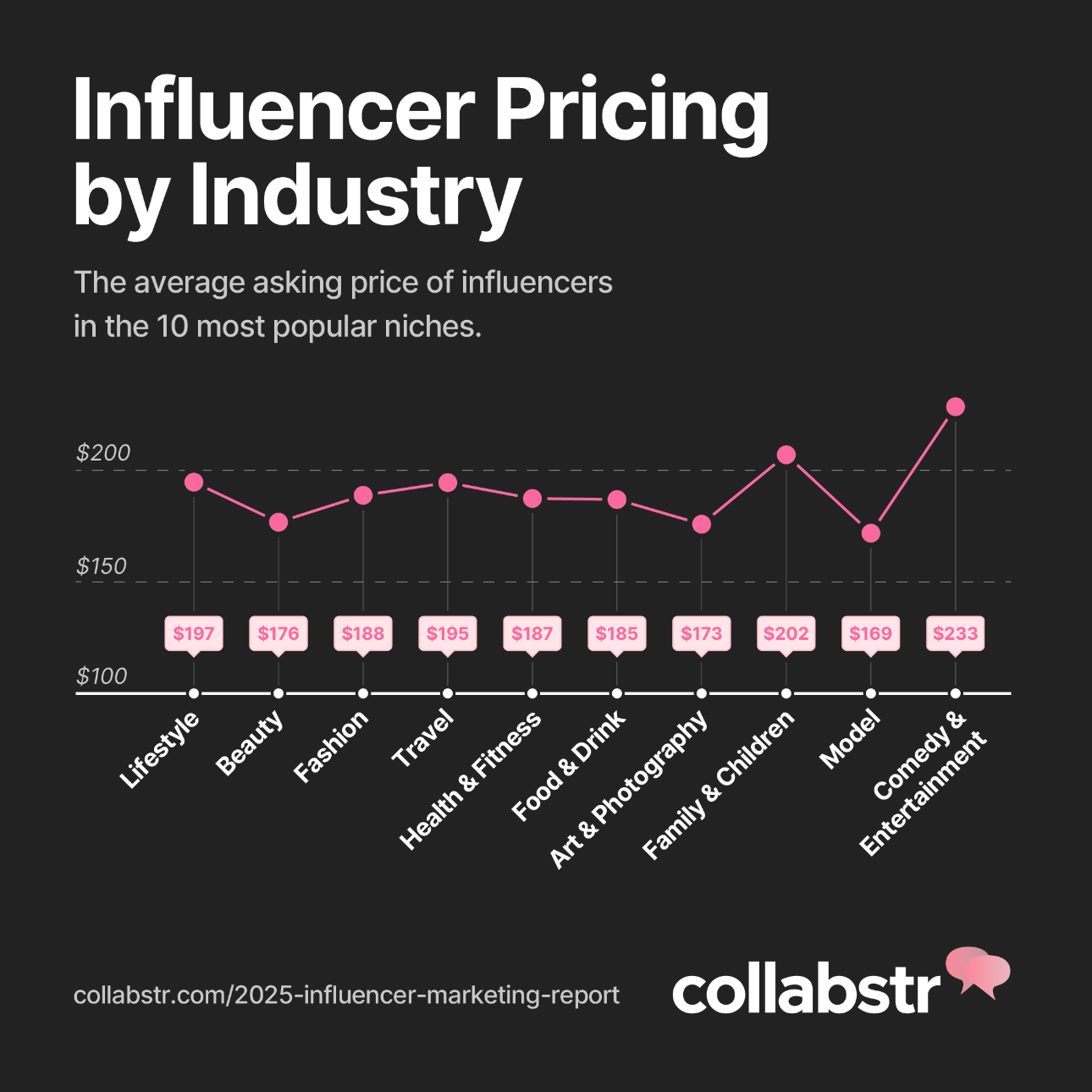
Collabstr
Influencer Pricing by Industry
Comedy & Entertainment commands the highest price of the most popular industries, with influencers in the Modeling sector coming in at the lowest, on average.
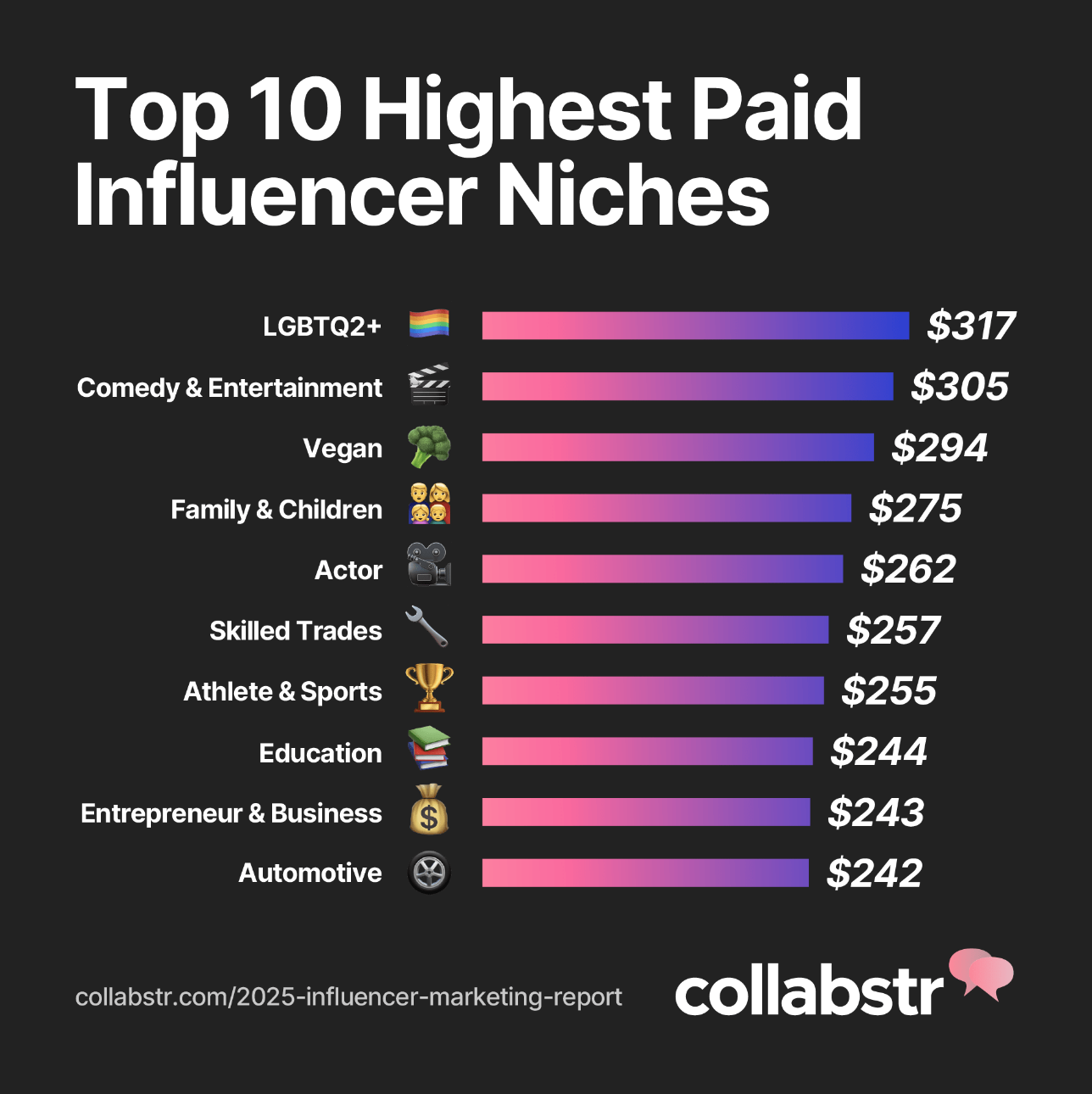
Collabstr
Top 10 Highest Paid Influencer Niches
In 2023, Acting, Celebrity & Public Figures, and Entrepreneurship & Business dominated as the highest-paid influencer niches. In 2024, there is a significant shift with LGBTQ+, Comedy & Entertainment, and Vegan content taking the top spots. This reflects changing audience interests, growing market opportunities, and the power of authentic, relatable voices in influencer marketing.
- LGBTQ+ Influencers have claimed the top position, earning an average of $316.78 per collaboration. Brands are recognizing the value of partnering with LGBTQ+ creators, whose authentic voices resonate with diverse audiences while promoting inclusivity and belonging. Research shows that LGBTQ+-friendly businesses are more profitable, making this niche a smart and impactful investment for brands.
- Comedy & Entertainment remains a lucrative niche at $305.12, thanks to its ability to engage audiences through humor and relatability. Comedy content drives high levels of interaction and positive brand recall, offering brands a creative and effective way to connect with their audiences on a personal level.
- The rise of Vegan influencers—earning $293.50 on average—reflects the booming plant-based movement, with the market projected to grow from $24.58 billion in 2023 to $27.8 billion in 2024. Influencers in this niche promote sustainability, health, and ethical eating, reshaping perceptions of veganism and inspiring change.
- Family & Children content has emerged as a high-paying niche at $274.57, fueled by a post-pandemic shift toward uplifting, family-friendly content. There's been a noticeable shift toward content that feels genuine and uplifting, showcasing families navigating everyday life. Audiences are increasingly drawn to these relatable stories, which offer an authentic glimpse into real-world challenges instead of idealized portrayals
- Athlete & Sports niches are also on the rise, earning $255.29 on average. Sports leagues, like the NBA, are betting big on influencer marketing to reach younger audiences. Collaborations with influencers, such as YouTuber Jesser's coverage of the NBA Finals, are creating new opportunities for leagues to tap into untapped markets beyond their traditional channels.
- Automotive influencers have secured a spot in the top 10, with an average earning of $242.11. Over 38% of car buyers now turn to social media campaigns and influencers before buying a vehicle. This growing trend underscores the power of automotive influencers to boost engagement and drive conversions through trusted content on platforms like YouTube, Instagram, and TikTok.
- The Education influencer niche, averaging $244.46 per collaboration, thrives because academic influencers—ranging from teachers and professors to college students—play a key role in bridging the gap between learning and technology. They promote tools like AI writing assistants and productivity apps, simplifying complex topics and making education more engaging and accessible through social media.
Finally, these niches have fewer creators than broader categories like beauty or lifestyle, reducing competition and allowing influencers to stand out. This exclusivity helps them build stronger audience loyalty, establish authority, and command higher prices for their expertise.
Highest Paying Cities for Influencers
- Salt Lake City, Utah: $421
- Saint Louis, Missouri: $363
- Ottawa, Ontario: $340
- Bloomington, Indiana: $342
- Fort Lauderdale, Florida: $324
Cities like Fort Lauderdale, Salt Lake City, and Ottawa are among the highest-paying for influencers, which aligns with their relatively high costs of living. Fort Lauderdale's cost of living is 20% higher than the national average, Salt Lake City's is 10% higher, and Ottawa is one of Canada's most expensive cities. These factors likely lead influencers in these areas to charge more to sustain their lifestyles, and brands targeting these regions must pay competitive rates to secure top talent.
However, St. Louis and Bloomington defy cost of living trends.
- Despite having a cost of living that's 6% lower than the national average, St. Louis ranks high in influencer earnings. This could be due to regional market targeting. Brands may see St. Louis as a strategic hub for midwestern audiences and invest in local influencers to establish strong connections within the community.
- With a cost of living at the national average, Bloomington's inclusion in the list may also be tied to local brand partnerships. Its university-town dynamic and highly engaged local community may create opportunities for influencers to build strong, region-specific followings, attracting brands looking for targeted marketing campaigns.
2025 Influencer Gender Breakdown
72% of Influencers are Female, while 28% are Male
In last year's report, female influencers were still leading with 70% and male influencers were at 30%, so not a significant change there.
The higher volume of female influencers and the female majority in popular influencer niches such as lifestyle and beauty is clearly what leads to the disparity. However, similar to last year's report, the higher the follower count, the smaller the gender disparity. The hypothesis remains the same: with larger creators, the focus tends to be on the value they drive rather than their gender.
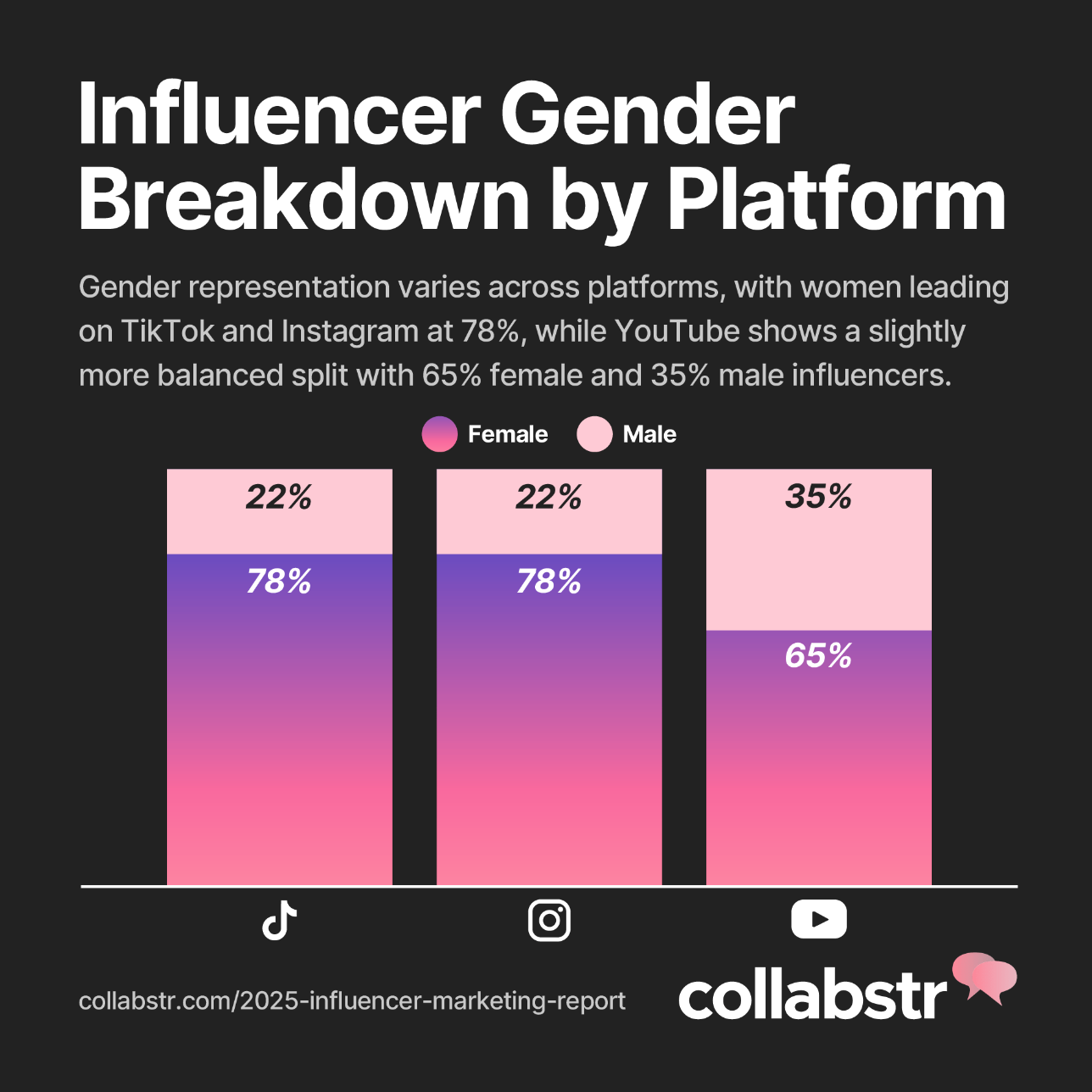
Collabstr
Influencer Gender Breakdown by Platform
On TikTok and Instagram, 78% of influencers are female. YouTube stands out as the most gender-balanced platform, with 65% female and 35% male influencers.
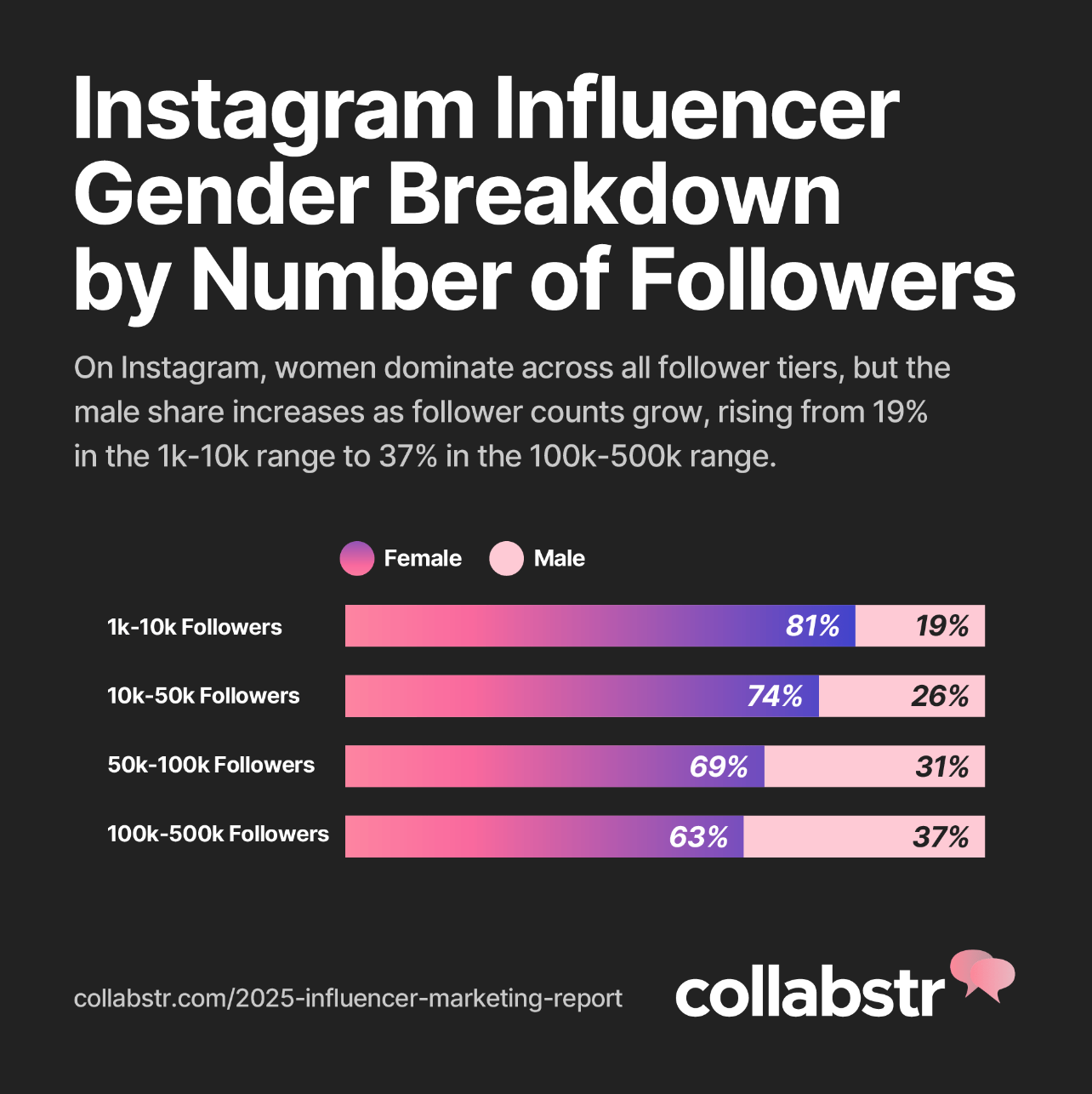
Collabstr
Instagram Influencer Gender Breakdown by Number of Followers
On Instagram, female influencers dominate every follower tier, starting with 81% in the 1K-10K range, dropping slightly to 74% in the 10K-50K range, and continuing to 69% in the 50K-100K tier. By the 100K-500K range, females hold 63%, showing a gradual narrowing of the gender gap as follower counts increase.
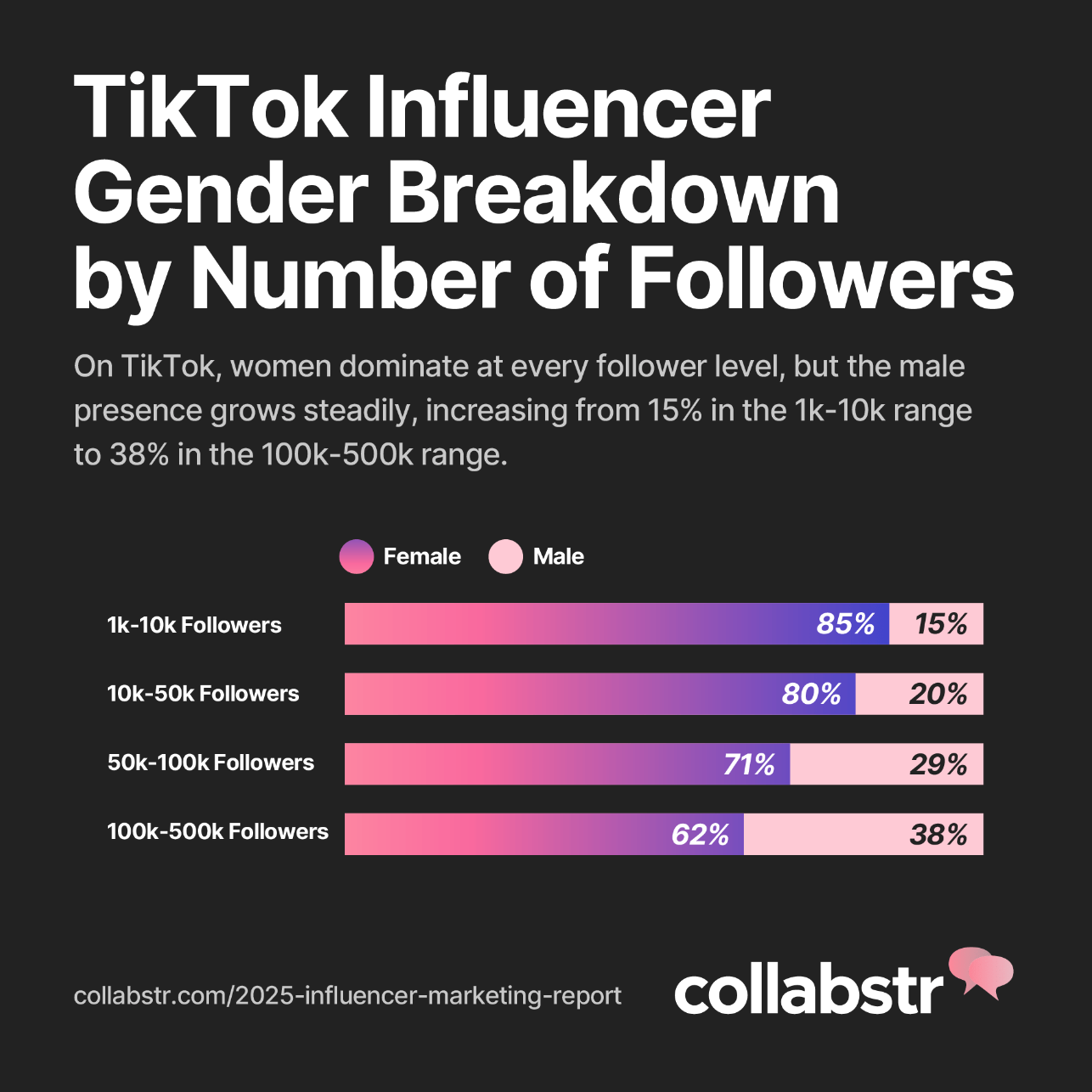
Collabstr
TikTok Influencer Gender Breakdown by Number of Followers
On TikTok, a similar pattern emerges. Female influencers make up 85% in the 1K-10K range and 80% in the 10K-50K range. The percentage decreases to 71% in the 50K-100K bracket and 62% in the 100K-500K range, indicating a steady increase in male representation at higher follower levels.
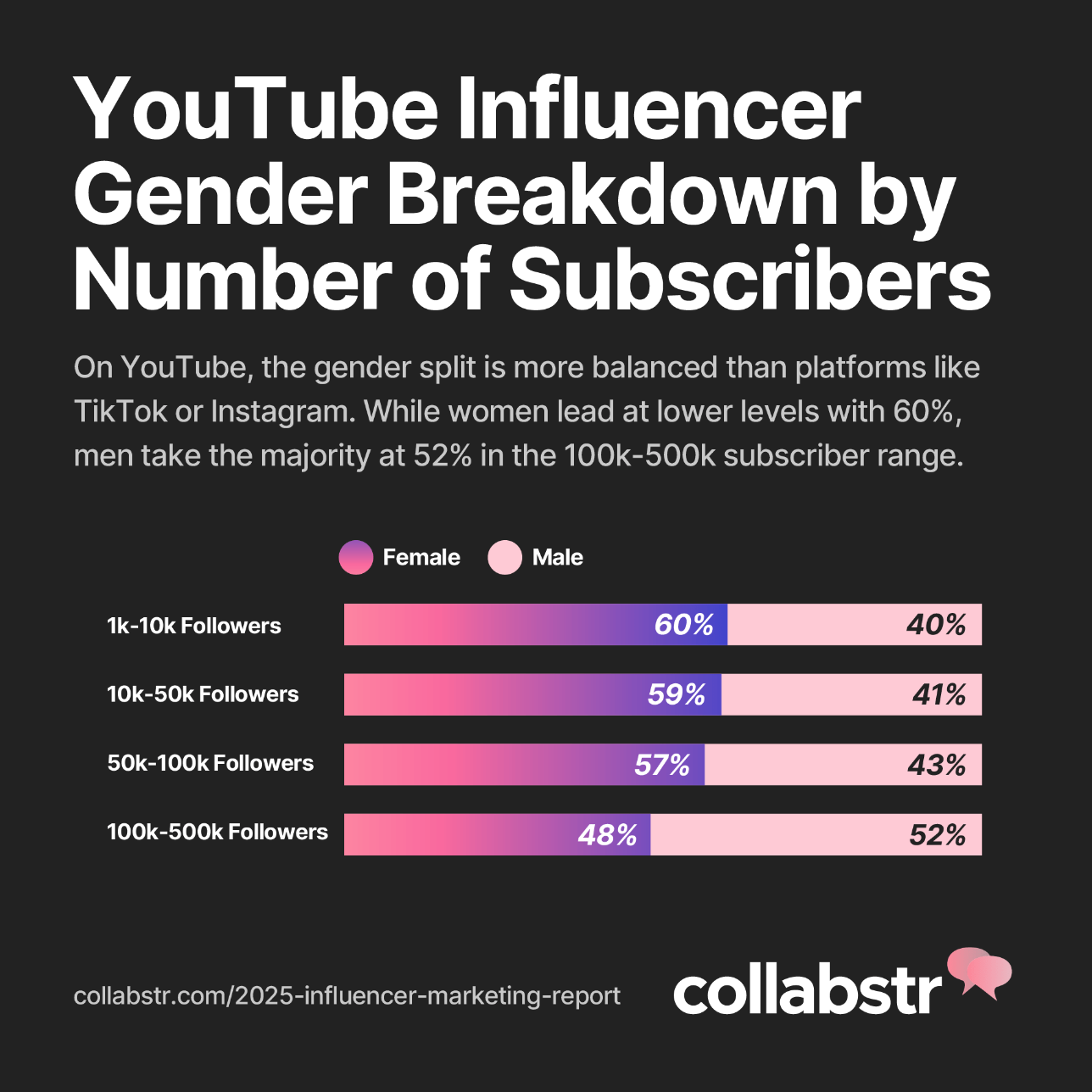
Collabstr
YouTube Influencer Gender Breakdown by Number of Subscribers
On YouTube, the gender gap is less pronounced, and the trend even reverses at higher subscriber levels. Female influencers lead with 60% in the 1K-10K tier and 59% in the 10K-50K range. However, the split becomes more balanced at 57% in the 50K-100K range, and males take the lead at 52% in the 100K-500K bracket.
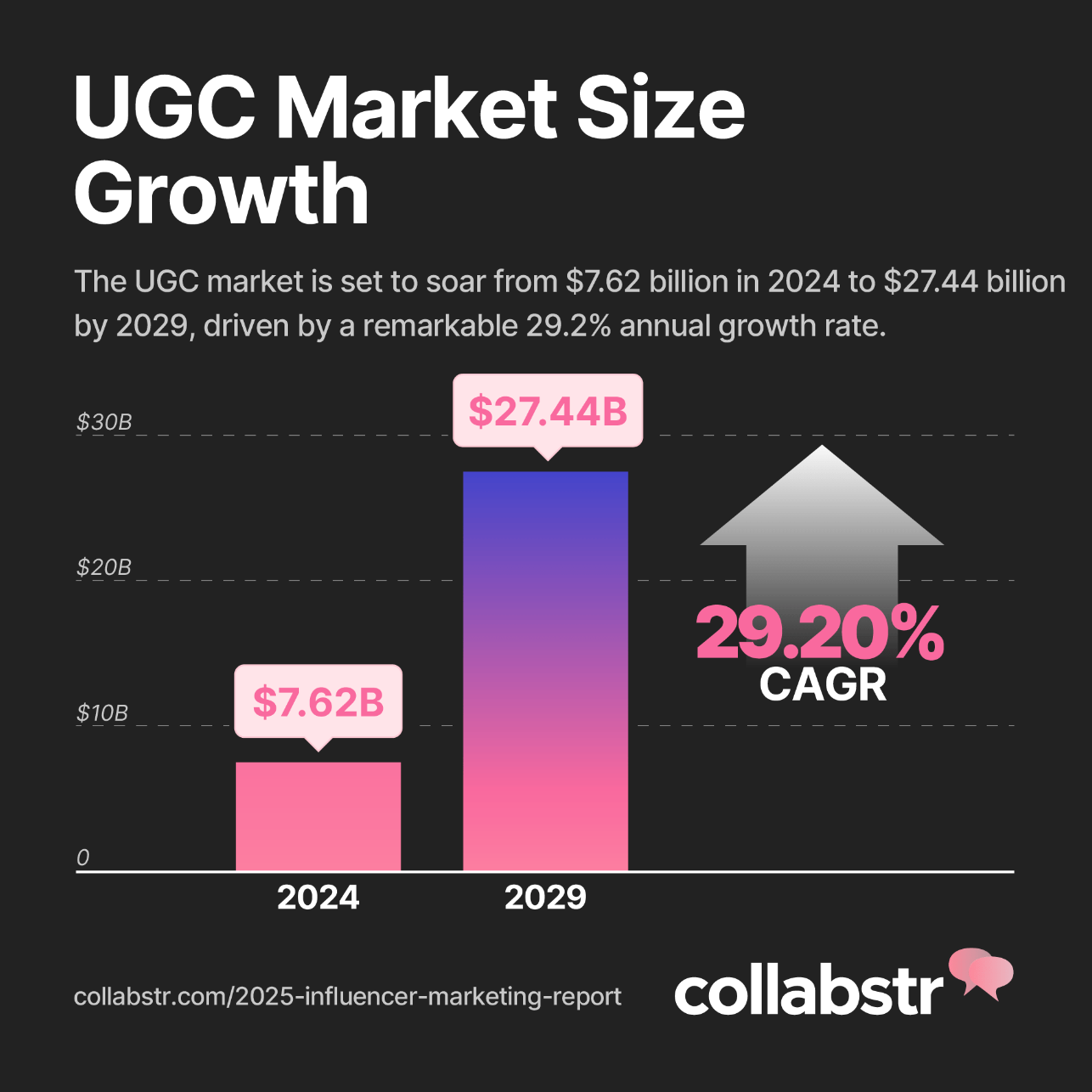
Collabstr
UGC Statistics and Trends for 2025
In 2024, the market size for UGC was USD 7.62 Billion. It's estimated to grow towards USD 27.44 billion with a compound annual growth rate (CAGR) of 29.20%
With marketing budgets under pressure, brands are increasingly turning to more affordable options like user-generated content and employee-generated content, or EGC. This shift is driven by the realization, largely demonstrated through influencer marketing, that authentic, relatable content resonates better with audiences than traditional brand-produced campaigns. As influencer marketing has shown, audiences prioritize trust and relatability, making UGC and EGC powerful tools for building genuine consumer connections.
How Many UGC Creators Are There?
Collabstr found that 66% of all creators are open to UGC work, and offer UGC services to brands. This is up from last year, when only 26% of creators were open to offering UGC services to brands. Creators are likely seeing an opportunity to diversify their sources of income as brands are learning that UGC creators can be more cost-effective than traditional marketing methods.
What Is the Average Number of Social Media Accounts for a Creator?
On average, creators have two social media accounts that they are actively monetizing. Last year, the number was roughly the same. Being present in more than one social channel helps them build a brand, while still being able to nurture engagement and repurpose content.
How Long Does it Take to Finish an Influencer Collaboration?
On average, it takes brands 14 days to complete a collaboration with an influencer, a turnaround time that remains unchanged from last year.
It's important to note that turnaround time depends on both influencers and brands. Factors such as the type of collaboration, the number of deliverables, specific requirements from the brand or influencer, and whether the brand needs to send out products for reviews can all impact how quickly a campaign is executed. For example, product send-outs may rely on traditional supply chains, adding extra days to the process, while simpler campaigns with fewer demands may move more quickly.
According to creative agency Linney, "Influencer marketing is extremely reactive. Campaign deadlines can change at the drop of a hat. To adapt to changing campaign or trend needs, brands must embrace agility. By adjusting the process based on the campaign type and turnaround time, brands can serve timely content to content creators, getting their brand noticed while resonating with their audience."
Influencer Marketing Platforms are helping streamline this process by connecting brands and influencers more efficiently, reducing the time it takes to start collaborations. Such platforms are addressing the need for agility, making it easier for brands and influencers to meet tight deadlines and deliver timely, trend-responsive content. As these tools become more widely adopted, turnaround times are likely to decrease in the coming years.
Influencer Marketing Predictions for 2025
Keeping a Vigilant Eye on AI
AI has remained a bustling topic ever since ChatGPT exploded in January 2023. In 2024, it still holds its spot among the top trends of the year.
In 2025, things won't be any different.
From streamlining manual work to its ability to generate "fake" influencers, AI is set to change the scene for influencer marketing.
AI's time-saving role in influencer marketing
Saving time with scouting, campaign briefs, campaign management, content optimization, visual strategy and ideation, and more.
The market potential for AI influencers
AI influencers closely resemble real influencers. Popular examples include Lu do Magalu, Lil Miquela, and ROZY. They post their brand deals, vacations, daily life, and collaborations with other AI influencers.
The question is: Will brands want to work with AI-generated influencers instead of human influencers?
The answer is yes. Virtual influencers can be cost-effective in comparison to human influencers. "Switching from human to AI influencers can lower campaign costs by up to 30%, eliminating fees, travel and logistics expenses," David López López, a senior lecturer and associate dean at Esade Business & Law School, writes in Forbes, citing data from Gartner. "This makes AI a viable option for large companies requiring round-the-clock audience engagement."
Influencers like ROZY are already closing profitable brand deals:
"Photorealistic and seamlessly integrated into social media, Rozy is nearly indistinguishable from a human," writes Gloria Maria Cappelletti, editor in chief & creative director at RED-EYE. "Her jet-setting lifestyle and partnerships with fashion brands like Max & Co. and CAHIERS create an illusion of authenticity so compelling that it's hard not to feel connected to her."
That said, there are several downsides to keep in mind:
- Despite their impressive human-like appearance and ability to engage with an audience, AI influencers often struggle to maintain the genuine authenticity that audiences crave. While they can mimic human behaviors, their lack of true life experience and emotions can create a disconnect, making it harder for audiences to form a real connection.
- With the rise of AI influencers and deepfake videos, legal questions are emerging around copyright, ownership, and the regulation of AI-generated content. As AI laws evolve, brands and creators will need to tackle these complex issues, potentially facing challenges around transparency, disclosure, and ethical practices.
Furthermore, creating a sophisticated AI influencer like Lil Miquela requires significant resources, including proprietary technology development, 3D rendering, motion capture, and machine learning. While this process isn't cheap, the rise of AI influencer generators and subscription-based tools has made it more accessible and cost-effective for brands to create their own virtual personas.
This democratization of AI influencer creation raises the question: is the high cost still a valid concern when these tools can streamline the process for much lower investment? Is the investment worth it for the output? That's up for brands to decide.
Other Predictions to Keep In Mind
Bluesky has seen an increase in users since the US presidential election in November 2024, climbing to 24 million users. Text-centered platforms are very similar to Twitter, but still not as popular as TikTok and Instagram in the influencer scene.
Speaking of TikTok, TikTok Shop has had a year of massive growth, challenges, and uncertainties. In 2023, it quickly became a large e-commerce player, leveraging the platform's massive user base and algorithm-driven discovery to connect buyers and sellers seamlessly. The numbers speak for themselves: 81.3% of purchases on TikTok Shop came from repeat customers by early 2024, signaling strong buyer satisfaction and loyalty. Additionally, social commerce sales are projected to more than double by 2027, with TikTok positioned to capture a significant share.
While fast fashion and wellness brands thrived on the platform, the looming threat of a U.S. ban on TikTok created uncertainty for sellers and buyers alike. Yet, despite this potential disruption, TikTok Shop shows no signs of slowing down. The platform expects U.S. commerce sales to grow tenfold to $17.5 billion by the end of 2024, demonstrating strong confidence in its ability to weather regulatory headwinds.
Looking ahead, TikTok Shop will likely continue evolving, driven by repeat buyer loyalty, rising merchant adoption, and its algorithmic advantage. Whether it becomes a long-term staple of e-commerce or remains a short-lived trend will depend on how it navigates both consumer preferences and political landscapes in the coming years.
Wrapping Up: Key Trends Shaping Influencer Marketing in 2025
Looking ahead, influencer marketing is becoming more cost-effective for brands. Lower collaboration fees across platforms and the increasing availability of UGC creators mean campaigns are more accessible, even for smaller budgets.
At the same time, the growing number of creators across diverse niches makes it easier for brands to find the right fit for their campaigns, allowing for more personalized and impactful partnerships.
To manage this expanding talent pool, many brands are turning to AI in order to streamline influencer campaigns, handling everything from administrative tasks to content delivery. With tools that automate workflows, reduce logistical delays, and enhance content creation, brands can execute campaigns more efficiently and at scale.
Together, affordable pricing, a wider pool of creators, and AI-driven efficiencies are setting the stage for a more dynamic and adaptable influencer marketing scenario. Brands that embrace these shifts will be better positioned to create meaningful connections with their audiences and achieve measurable results.
This story was produced by Collabstr and reviewed and distributed by Stacker.
